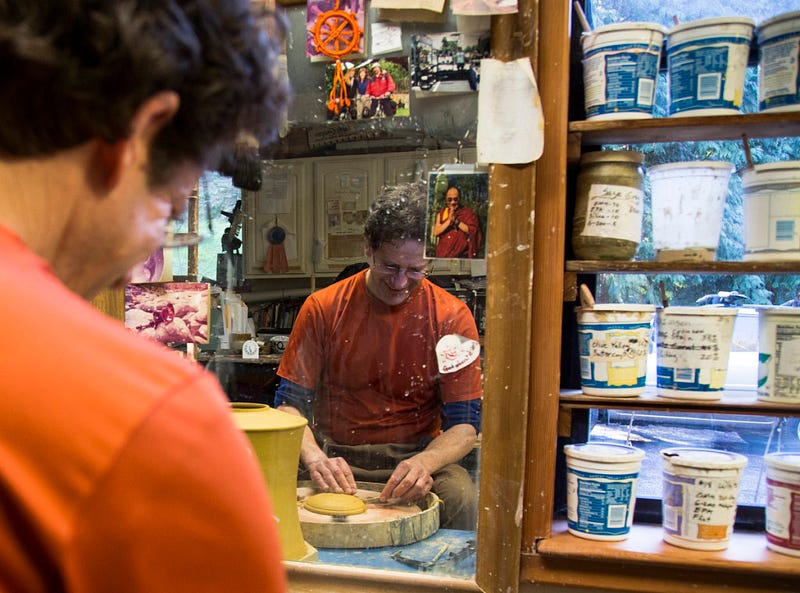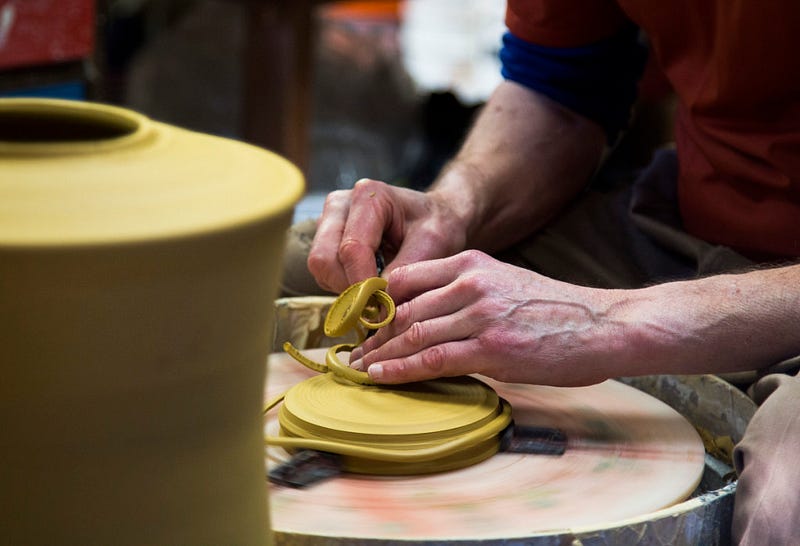Wheel of Mindfulness
Putting a new spin on an ancient tradition
STORY BY HALEE HASTAD | PHOTOS BY TOMMY CALDERON
(above) Christopher Moench stands next to a prayer wheel that is currently a work in progress, Feb. 14, 2015. The prayer wheel features imagery of the Pacific Northwest. Tommy Calderon | Klipsun Magazine
Chris Moench sits at the potter’s wheel he has owned since he was in high school. His head bows and with one smooth kick his foot sets the wheel in motion. Spinning, spinning, spinning, a piece of clay slowly takes shape with each movement of his hands.
Moench, 56, from the front yard workshop he built by hand, is crafting the lid for a prayer wheel.
Prayer wheels are ritual objects that originate from Buddhist practices in Tibet and Nepal. Some are as large as a two-story building while others are no bigger than a yoyo. All of them are believed to possess spiritual forces.
Traditional wheels revolve clockwise to follow the rotation of the sun and are believed to cleanse energies of users or the wider world. Owning a prayer wheel is part of a mindfulness practice. Most wheels show an inscription or illustration of a prayer scene and contain rolled verses on the inside.
They are honored as symbols of enlightenment and believed to increase the mind’s capacity for wisdom. Just as a potter’s wheel spins clay into art; a prayer wheel spins blessings into the universe.
Moench says his wheels are not necessarily Buddhist, but share a similar concept as well as intent. Being meaningful storytellers, he says the hand-made vessels remind people of the transformations that led them to the present moment.

His intention was never to make a prayer wheel though. It was an accident.
In 1999, the Olympic Pipeline explosion in Whatcom Creek killed one young man and two boys, as well as destroyed a fragile habitat. It was this tragedy that inspired Moench to construct something for the grieving community of Bellingham, Washington.
“I was afraid [the explosion] would become just another story and that people would forget about the transformative impact it had on our community,” he says. “My thought was to create an intentional acknowledgement of the collective economy we live in and on.”
Following a year of post-explosion reflection and meditation, Moench got to work on a hollow, three-foot-tall clay cylinder with an illustration of the creek depicted on the outside. He didn’t know then that he had made a prayer wheel, but learned about the concept afterwards while travelling in Southeast Asia.
Fourteen years later, Moench’s one-man company, Axis of Hope, has produced more than 1,000 of these unique ritual objects.
His wheels range in price from $400 to $10,000 and can be found all over the country.
They spin in hospital rooms, personal offices and entryways of homes. The wheels differ in design and almost all of them depict a nature-related scene on the outer surface. For Moench, who has always loved the environment, honoring life-giving resources provided by the planet is central in his creation.
Most of the vessels are gifts for those who are going through any sort of remarkable life experience. Such as a marriage, birth, divorce, retirement, illness or death, he says.
One of Moench’s first wheels spins at Bellingham Physical Therapy and owners, Marcia and John McWilliams, honor its presence in their practice.
“Our wheel has become part of who we are and who our patients are here,” the McWilliams say.
Remove the lid of their wheel and find a once hollow space filled to the brim with pieces of paper.
Patients and their families write their expressions on the scraps, place them in the wheel and give it a spin — a way to release their thoughts, struggles and wishes into the universe, Marcia says.

Tibetan tradition teaches that each time the vessel makes one spinning rotation the prayers inside are activated and released into the universe.
The McWilliams believe the wheel is a calming force in the space because it allows users to connect with a spiritual sense that is both unexplainable and often hard to grasp, they say.
“It’s very difficult to explain an experience [with the wheel], much like it is very difficult to explain the taste of an orange without using the word ’orange’,” John says.
For Moench, the wheels are a way for people to connect with their inner-selves, to cultivate mindfulness and to remember the things that matter most to them.
As a personal touch, he stamps the words “love,” “peace,” “compassion,” and “gratitude” into the base of each wheel as a way to personalize every piece and send it off with a part of his personal intention.
Sitting in his workshop, he lifts the lid he is crafting and carefully places it atop the almost finished prayer wheel. A nearly perfect fit.
